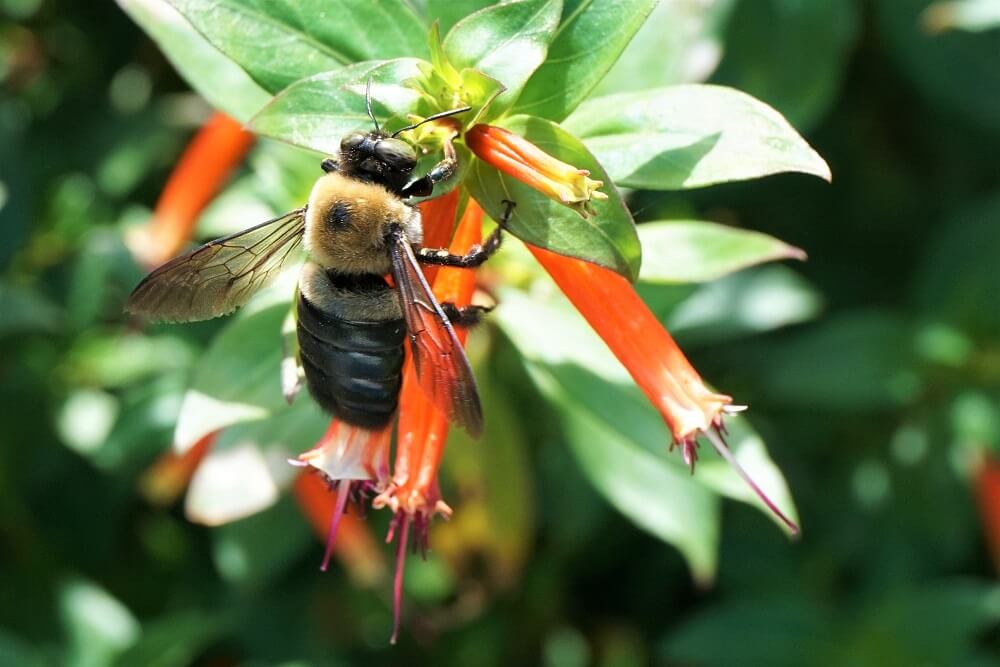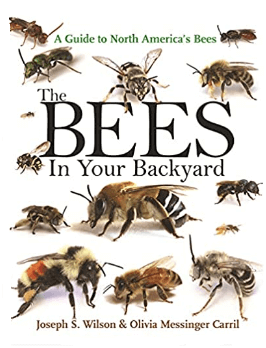In this article:
Do Carpenter Bees Pollinate?
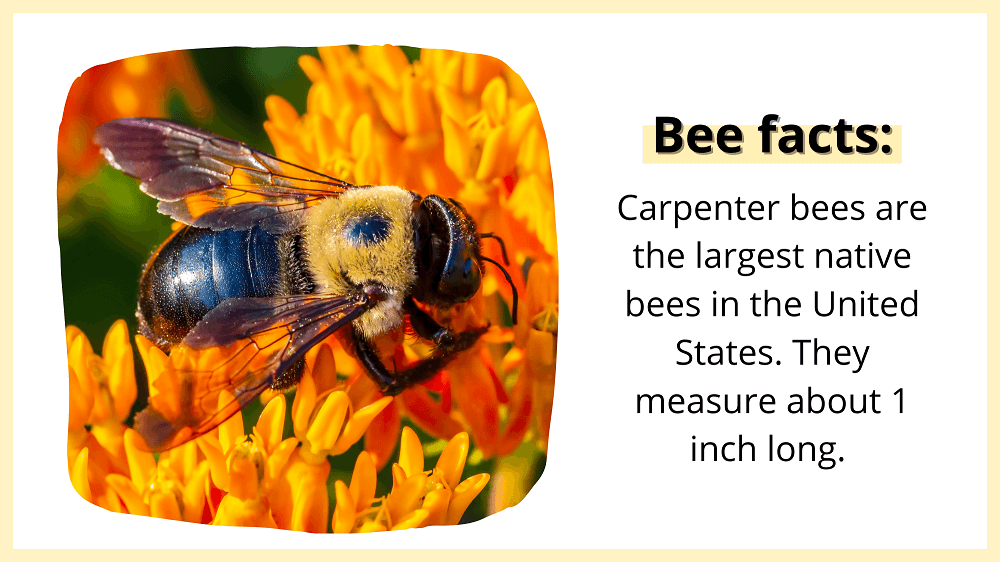
Yes, carpenter bees are incredible pollinators that play a crucial role in our ecosystem.
Think about it.
Through their pollination, carpenter bees help increase crop yields and quality. In fact, fruits like blueberries and cherries are 90% dependent on carpenter bees, honeybees, and bumblebees.(1)
And if that wasn’t enough?
Up to 15% of our crops are pollinated by native bees such as carpenter bees.
And here’s the cool part:
Carpenter bees are the biggest bees in North America.(2)
Because of their size, these gentle giants can do things that other bees can’t. For example, rain and wind can easily knock smaller bees out of the sky.
But for carpenter bees?
Not so fast.
They can continue to pollinate in rainy or windy weather. Their size and strength allow them to fly during times in which smaller bees can’t risk it.
Related: Do Carpenter Bees Sting?

So what am I saying?
It’s time to release the stigma surrounding carpenter bees.
People often ask me, “Do carpenter bees do anything good?” as if these bees are nothing but pests.
The truth, though?
Carpenter bees are wonderful creatures that help our environment. Sure, they can get annoying when they drill holes into your wood, but there are natural ways to deter carpenter bees without hurting them.
With that out of the way, let’s take it a step further. Now the question becomes:
How do carpenter bees pollinate flowers?
Simple.
They use a technique called buzz pollination. During buzz pollination (also called sonication), carpenter bees quickly vibrate their wings. This vibration causes the pollen to shake out of the flower and fall onto the bee’s body.
This is why you hear carpenter bees buzz away as they collect pollen.
More importantly:
Not all bees are buzz pollinators, and so far, only a few types of bees are known to do it.
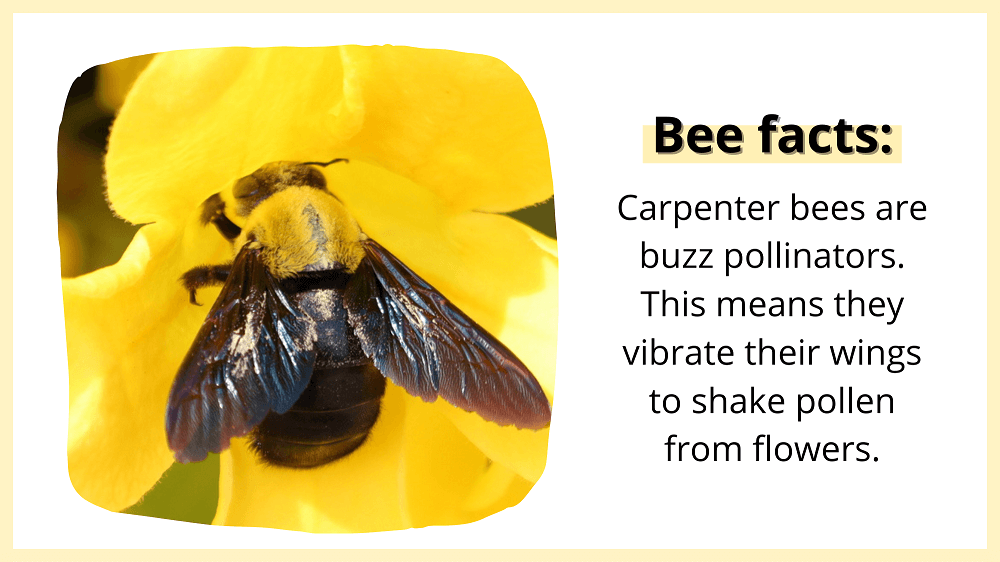
So why is buzz pollination essential?
Because it’s the key to unlocking pollen from certain flowers. You see, pollination happens when pollen grains transfer from the male of one flower to the female stigma of another flower. This results in plant fertilization.
But, certain flowers hide a secret stash of pollen deep within their anthers (the male parts of the plant). This is where carpenter bees come in.
Major crops like tomatoes, blueberries, kiwis, and eggplants get help from buzz pollinators like carpenter bees.
And while tomatoes are self-pollinating, carpenter bees still help by nudging the flowers just enough to help dislodge the pollen from the stamens.(3, 4, 5)
And you know what else?
Carpenter bees are fast workers.
Related: Do Bumble Bees Make Honey?
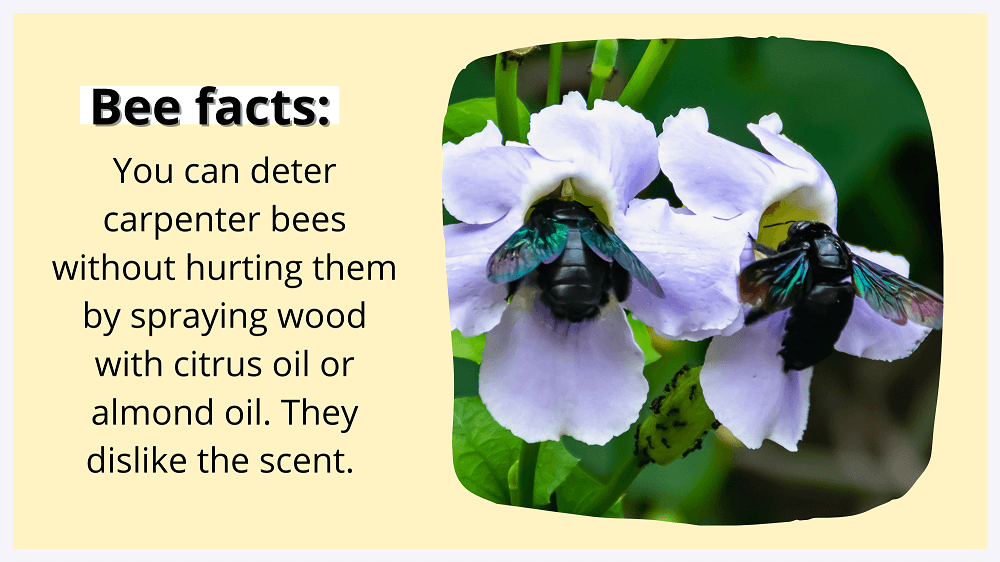
The only problem?
Carpenter bees get a bad rap.
For one, they’re known for boring holes into wood to build their nests. For two, male carpenter bees “dive bomb,” which means they buzz around you to scare you away from their nests.
But don’t worry.
Male carpenter bees are all talk.
They can’t sting you because they don’t have stingers. Only the female carpenter bees have stingers, but you’re less likely to encounter a female because she’s busy tending to her baby bees.
Also, carpenter bees are called “gentle giants” for a reason. They’re docile bees that only sting under extreme circumstances, such as being touched.
Now you might be asking…
Related: Honeybees vs. Bumblebees: How Do They Compare?
Should I Leave Carpenter Bees Alone?
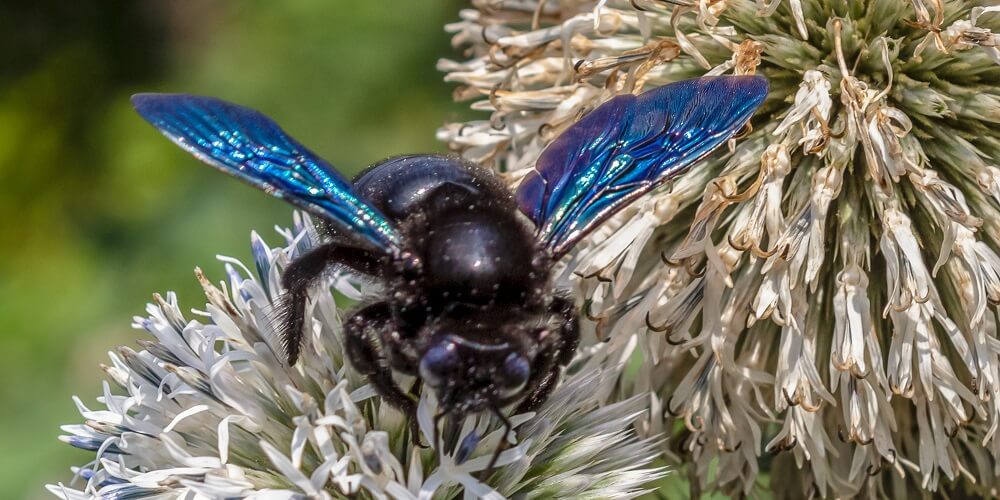
Yes, it’s best to leave them alone if they aren’t drilling holes in your wood. Carpenter bees are valuable pollinators that do good things for the environment.
In short:
We need pollinators like carpenter bees.
They’re also gentle bees that are unlikely to sting unless seriously provoked. Sure, they may buzz around you out of curiosity or to deter you from their nests, but that’s usually the extent of what they’ll do.
But.
If carpenter bees are drilling holes in your wood, you should naturally deter them using methods that won’t hurt them.
Read our guide on how to get rid of carpenter bees for more information.
Now here’s a question for you:
Do you want to plant a bee-friendly garden?
Let’s talk about that next.
Related: How Many Eyes Does a Bee Have?
What Plants Do Carpenter Bees Pollinate?
Carpenter bees pollinate many types of flowers. Here are a few of their favorites:
Lavender
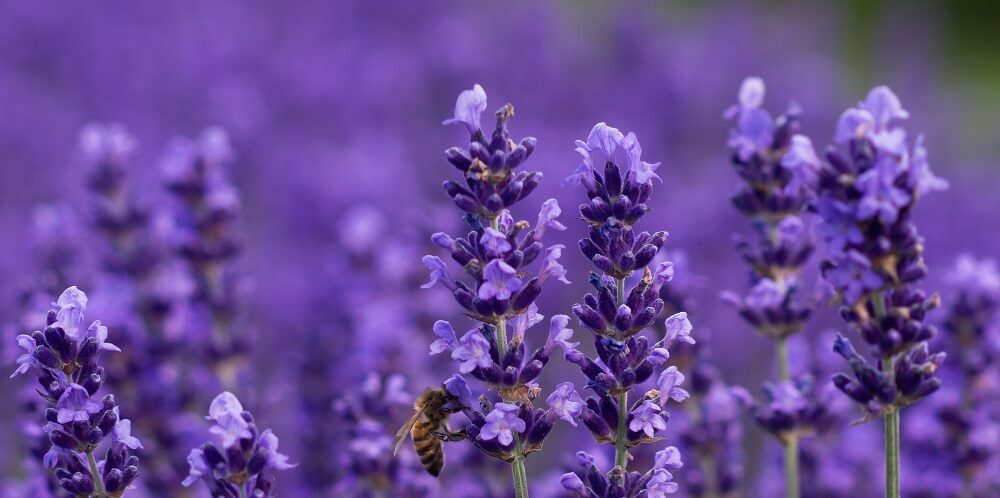
If you’ve ever asked yourself, “What is a carpenter bee’s favorite flower?” or “What flowers do carpenter bees like?” then lavender may be your answer. From spring through summer, this fragrant herb attracts many species of bees.
Even better?
Lavender is a versatile plant ideal for pots, gardens, and flowerbeds.
Lavender prefers full sunshine and well-drained soil. In hot summer areas, afternoon shade may be necessary. In Zones 1-6, it’s best to plant lavender in the spring or early summer. In Zones 7-10, lavender should be planted in the early fall, so the roots have a chance to become established.
Lavender grows at a moderate pace, often growing a few inches yearly.
Lavender is an excellent companion for many plants, including roses and cabbage. It’s a fragrant, gray shrub that deer avoid, making it an excellent decoy in your beds.
But, be cautious if you have pets since lavender can be toxic to animals like dogs and cats.
Related: How Long Do Bees Live?
Catmint

Catmints produce beautiful spikes that carpenter bees find appealing.
Catmint (Nepeta) is a perennial herb from the mint family. It’s simple to grow with few problems or pests. The flowers can be lavender-blue, pink, or white.
Most catmint varieties sprawl outwards as they grow. This makes them lovely plants for edging or along pathways. As with many fragrant, gray-foliage plants, catmint is deer-resistant. It grows fast and can be planted in most climates from spring to early fall.
The best place to plant catmint is in a sunny location with well-draining soil. Most catmints are bushy plants that reach between 10-24 inches tall and 12-24 inches wide.
However, there are some compact varieties. New catmint varieties are being introduced often, so it’s good to shop around and read the plant descriptions before you pick one.
Related: What Do Bees Eat?
Salvia
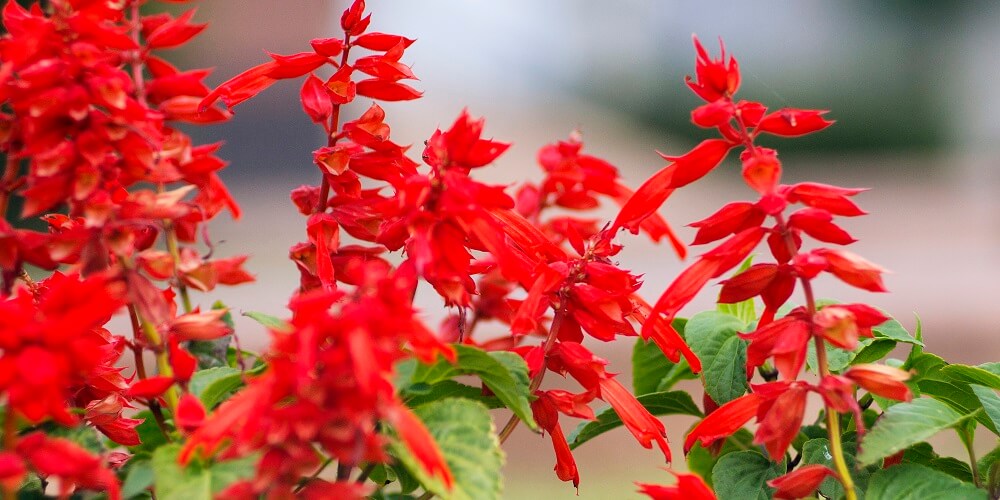
From a pollinator perspective, salvia is beautiful to carpenter bees, honeybees, many other native bees, and butterflies. In a nutshell, the salvia plant family is a magnet for all types of pollinators.
Perennial Salvias (also known as “sage”) make perfect garden borders that bloom from summer to fall.
Their colorful spikes are stunning. You can find them in several colors, including blue, purple, pink, red, white, and yellow.
As with many plants, picking the right spot for your salvia makes a difference in how well it grows. Most salvias prefer sunny locations with good drainage. You also have the option to grow them in containers. Salvia plants don’t need rich soil, but nice drainage is a must.
Related: Do Sweat Bees Sting or Bite?
Daylilies

Carpenter bees flock to daylilies along with other pollinators like butterflies, hummingbirds, and flies. Their appeal is the cup-like shape that makes them easy to gather nectar from.
If there’s a “sure bet” perennial, it’s probably the daylily. They thrive from Florida up to Minnesota and tolerate various soil conditions. They’re not bothered by many pests or diseases, and they bloom well with little attention.
The daylily’s botanical name, Hemerocallis, means “beauty for a day.” This comes from the fact that daylily flowers open in the morning and die by night. That said, each flower stem contains at least a dozen flower buds, so daylilies remain in bloom for many weeks.
Daylilies have the best chance when planted in full sun on moist, well-drained soil. In hot climates, they may require some afternoon shade.
In general, daylilies require little attention. They don’t need fertilization other than a yearly addition of compost.
Related: How Many Bees Are in a Hive?
African Blue Basil
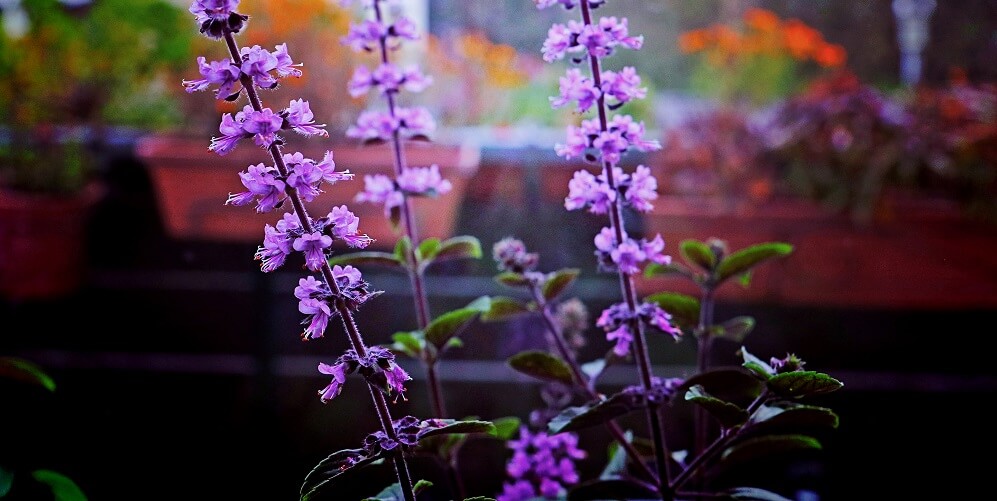
The amount of pollinator activity on African Blue Basils makes them a perfect addition to your bee-friendly garden. Everything from carpenter bees to honeybees to beneficial wasps loves this plant.
They’re full of pollinators when in bloom.
Plus, these plants are entirely edible. This includes the flower, leaves, and stems. In cooler climates, it can be grown as an annual herb.
It has a strong aroma that carries beautifully in the wind. This herb is often used to season salads, soups, sauces, and pesto. It has a stronger flavor than sweet basil, so it only takes a few leaves to add a kick of flavor.
African blue basil thrives best in a climate with temps between 68-95°F (20-35°C) since it’s considered a tropical plant.
Winter temperatures below 40°F (4°C) are too cold for African blue basils. That said, this plant can be grown in pots and overwintered indoors.
Related: Why Do Vulture Bees Eat Rotting Flesh?
Oregano
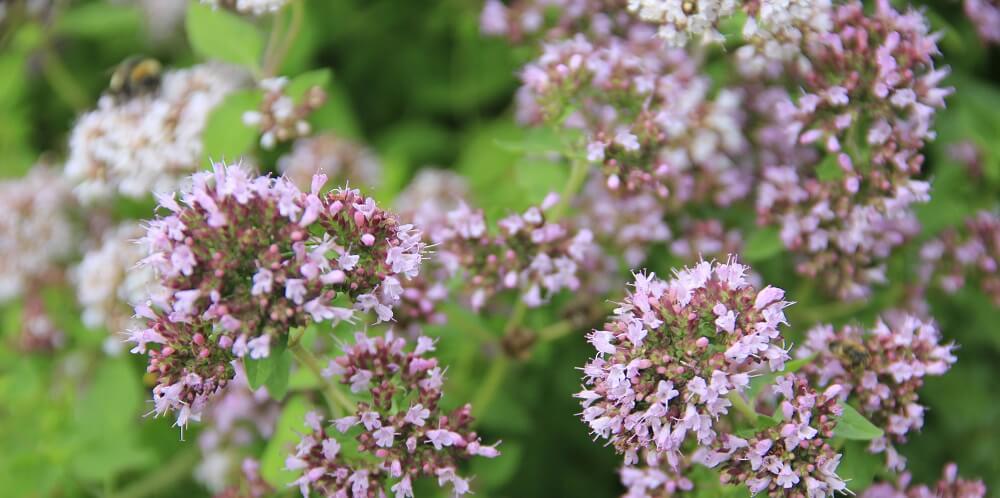
Want to bring carpenter bees buzzing to your yard?
Purple oregano will do the trick.
People know this plant best as simply called “oregano,” which is also the scientific name – origanum vulgare.
Oregano leaves are oval and dark green. Some varieties have fuzzy leaves while others don’t. Oregano starts as a ground-hugging plant, but it can easily reach 24 inches tall.
It’s generally planted in the spring or fall, with leaves that grow quickly and are suitable for cooking almost immediately.
Oregano is a Mediterranean herb that grows well in full sun and well-drained soil. Soil, moisture, and climate can influence the oregano’s flavor, with rich soil tending to dilute its pungency. It’s a good plant for sunny areas of your yard with poor soil.
Oregano can be started from seeds pretty easily, or you can use cuttings from an established plant. Purple Oregano handles heat and drought well and is an excellent addition to flower beds.
Rock Purslane
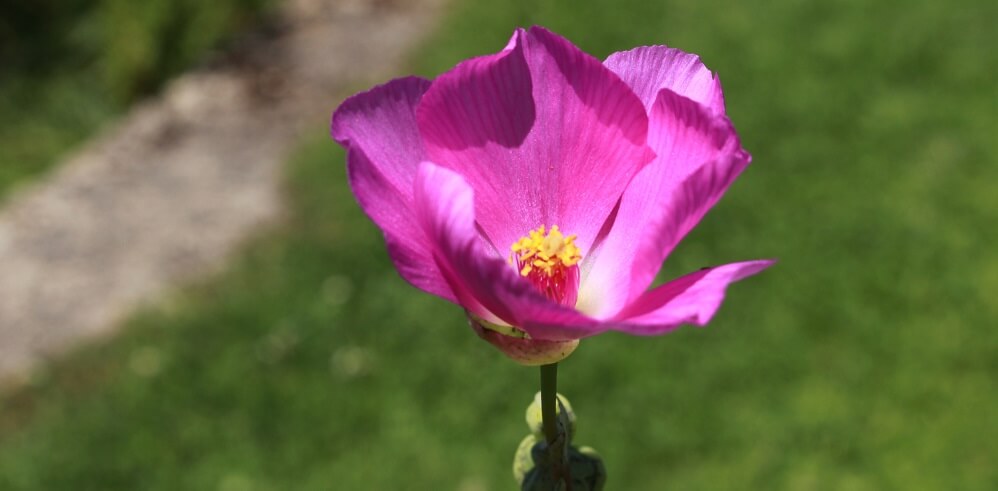
If you plant rock purslane in your garden, be prepared for a posse of carpenter bees and other pollinators. These flowers produce pink and bright purple blooms that attract bees and butterflies from spring through fall.
Rock purslane can grow well in most soil types as long as it’s well-drained. Gritty or sandy soil is a great choice. You can also use a good quality potting mix to grow this plant while adding a little coarse sand to improve drainage.
Rock purslane quickly grows to about 12 inches tall to 4 feet wide.
The succulent foliage has a blue-green color and is very thick. It’s easy to grow and maintain, so it’s a good plant for beginner gardeners or those who don’t want a lot of hassle. They’re excellent ground covers and work well for stopping the erosion of sandy soils.
If you live in warmer climates, this plant does wonderfully in light afternoon shade. In other climates, it does well in full sun.
FAQs on “Do Carpenter Bees Pollinate?”
- Do carpenter bees pollinate or make honey?
- Do carpenter bees destroy flowers?
- Are carpenter bees a protected species?
- Do carpenter bees pollinate like bumblebees?
Do carpenter bees pollinate or make honey?
Yes, carpenter bees pollinate, but they don’t make honey.
Carpenter bees aren’t like honeybees who live in hives. They have a unique ability to bore into wood to make their nests.
Making honey is a tedious process that only certain types of bees can perform. Honey production requires several bees working together. This means only social bees are capable of making honey.
Carpenter bees are solitary bees that don’t live in hives. Unfortunately, the effort required to make honey is impossible for them since they don’t live in large groups.
—> Go back to the FAQs on “Do carpenter bees pollinate?”
More to Explore:
Do carpenter bees destroy flowers?
No.
This is a common myth spread because carpenter bees have been labeled “nectar robbers.”
The term “nectar robber” sounds terrible, but it really just means that carpenter bees sometimes cut into the corolla of plants to get nectar.
Why do they do it?
Because they’re giant bees that can’t always fit inside a blossom to gather nectar. They also might not have long enough tongues to reach the nectar source.
But here’s the thing:
People always assume that nectar robbing hurts plants. But that’s not necessarily true.
The authors of a paper published in the Ecological Society of America studied the last 50+ years of research about nectar robbing. They found that nectar robbing could have a beneficial or neutral effect.(6)
Here’s what they said:
“The effects of nectar robbers are complex and depend, in part, on the identity of the robber, the identity of the legitimate pollinator, how much nectar the robbers remove, and the variety of floral resources available in the environment.”(6)
I’ve watched carpenter bees drill holes into flowers to gather nectar. Then, I’ve watched hummingbirds come right behind them and use those holes to get the rest of the nectar more easily. So to me, it’s helping more than it’s hurting.
So if you’ve ever asked yourself, “Should carpenter bees be killed?” the answer is no. They’re beneficial pollinators that get a bad rap. If they’re drilling holes in your wood, you can quickly learn how to get rid of carpenter bees without harming them.
—> Go back to the FAQs on “Do carpenter bees pollinate?”
More to Explore:
Are carpenter bees a protected species?
No, they’re not considered a protected species, but they should be protected by everyday people. That’s why I’m a huge proponent of removing carpenter bees without hurting them. The natural approach works best.
—> Go back to the FAQs on “Do carpenter bees pollinate?”
More to Explore:
Do carpenter bees pollinate like bumblebees?
Yes, they do! Carpenter bees are often mistaken for bumblebees because they look alike. While they’re not the same bees, they share some things in common, such as size and buzz pollination.
